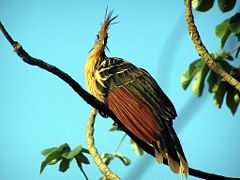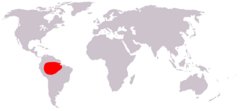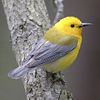Hoatzin
| Hoatzin | ||||||||||||||||
|---|---|---|---|---|---|---|---|---|---|---|---|---|---|---|---|---|
 |
||||||||||||||||
| Conservation status | ||||||||||||||||
| Scientific classification | ||||||||||||||||
|
||||||||||||||||
| Binomial name | ||||||||||||||||
| Ophisthocomus hoazin (Muller, 1776) |
||||||||||||||||
 Range of the Hoatzin
|
The Hoatzin (Opisthocomus hoazin), also known as the Hoactzin, Stinkbird, or Canje "Pheasant", is an unusual species of tropical bird found in swamps, riverine forest and mangrove of the Amazon and the Orinoco delta in South America. It is the only member of the genus Opisthocomus (Ancient Greek: wearing long hair behind, referring to its large crest),[2] which in turn is the only extant genus in the family Opisthocomidae. The taxonomic position of this family has been greatly debated, and is still far from clear. It is a roughly pheasant-sized bird some 65 cm (25 in), with a long neck and small head. It is brown in colour, with paler underparts and has an unfeathered blue face with maroon eyes, and its head is topped by a spiky, rufous crest. Herbivorous, it eats leaves and fruit, and has an unusual digestive system with an enlarged crop which functions as a rumen.
Contents |
Taxonomy

The Hoatzin was originally described by German zoologist Statius Muller in 1776.
The Hoatzin is arguably the most enigmatic living bird in regard to its phylogenetic relationships. No satisfying evolutionary hypothesis has been proposed, and the situation has actually become worse with the availability of DNA sequence data.
There has been much debate about the Hoatzin's relationships with other birds. Because of its distinctness it has been given its own family, the Opisthocomidae, and its own suborder, the Opisthocomi.[2] At various times, it has been allied with such taxa as the tinamous, the Galliformes (gamebirds), the rails, the bustards, seriemas, sandgrouse, doves, turacos, other Cuculiformes, and mousebirds.[2] Altogether, it has been most frequently suggested to be related to Galliformes, turacos, or the anis (New World cuckoos).
Placement with the gamebirds is historical, based mainly on phenetic considerations of external morphology, which are considered unreliable and generally dismissed today; the gamebirds together with the waterfowl belong to the fowl clade whereas the Hoatzin doesn't. Cladistic analysis of skeletal characters, on the other hand, supports a relationship of the Hoatzin to the seriema family Cariamidae, and more distantly to the turaco and cuckoo families. However, cuckoos have zygodactyl feet (two toes forward, two backward) and turacos are semi-zygodactylous, whereas the Hoatzin has the more typical anisodactyl foot with three toes forward, one backwards. The evolution of avian dactyly, on the other hand, is not entirely resolved to satisfaction.

Sibley and Ahlquist in 1990 considered it likely to be a basal cuckoo based on DNA-DNA hybridization. Avise et al. in 1994 found mtDNA cytochrome b sequence data to agree with Sibley and Ahlquist's previous treatment. Subsequently, Hughes and Baker in 1999 proclaimed to have "resolved" the relationships of the Hoatzin to be with turacos, based on their own analysis of 6 sets of mtDNA and one of nDNA sequences.
However, using mt and nDNA sequences of increased length, Sorenson et al. in 2003 noted that all three previous DNA studies were apparently flawed due to errors in methodology, small sample size, and sequencing errors; their study strongly suggested against a close relationship between the Hoatzin and cuckoos or turacos. It was not possible, though, to reliably determine the Hoatzin's closest living relatives. Even though it tended to group with doves, this was not at all well-supported, with little more than 10% likelihood at best that such an arrangement was accurate according to Sorenson et al's analysis.
Fain & Houde in 2004 proposed a dichotomy in the Neoaves (neognaths excluding fowl) based on β-fibrinogen intron 7 (FGB-int7) sequences. In their suggested phylogeny, the Hoatzin was a basal member of the Metaves, a proposed clade that would include many other historically problematic bird families, such as flamingos, grebes, tropicbirds, sandgrouse and mesites. While the doves did also group with the "Metaves", no close relationship between these and the Hoatzin was recovered.

On the other hand, while the other major Neoaves lineage, the Coronaves, largely agreed in its internal phylogeny with what is currently emerging as consensus,[3] the interrelationships of the "Metaves" were not well resolvable. Nor do supposed metavian groupings like flamingos and nightjars or tropicbirds and hummingbirds seem to have a factual basis rather than being bogus "clades" based on molecular homoplasies. The doves group, with low confidence, with the frogmouths in Fain & Houde's analysis.
Nonetheless, it seems probable that the taxa lumped in the Metaves by Fain & Houde (2004) do contain some good clades, such as Caprimulgiformes, the Mirandornithes, or the Apodiformes. Considering that some "odd Gruiformes" which might be each other's closest living relatives make up most of the remaining Metaves, doves, the Hoatzin, and sandgrouse would remain as "Metaves incerta sedis". This would seem to suggest that the Hoatzin is at least more closely related to doves than to any other living birds. Still, the analysis found a Hoatzin-doves clade, placing the frogmouths with some of what with near certainty are their actual relatives - other Cypselomorphae -, even less likely than the highly improbable dove-frogmouth grouping.
As regards other material evidence, the undisputed fossil record of the hoatzins consists of a single backside of the cranium of a fossil hoatzin, specimen UCMP 42823.[4] It is of Miocene origin[5] and was recovered in the upper Magdalena River Valley, Colombia. This has been placed into a distinct, less derived genus, Hoazinoides, but clearly would be placed into the same family as the extant species. It markedly differs insofar as that the cranium of the living Hoatzin is characteristic, being much domed, rounded, and shortened, and that these autapomorphies were less pronounced in the Miocene bird. Miller discussed these findings in the light of the supposed affiliation of the hoatzins and the Galliformes, which was the favored hypothesis at that time, but had been controversial almost since its inception. He cautioned, however, "that Hoazinoides by no means establishes a phyletic junction point with other galliforms." for obvious reasons, as we know today. Anything other than the primary findings of Miller are not to be expected in any case, as by the time of Hoazinoides, essentially all modern bird families are either known or believed to have been present and distinct. Going further back in time, the Late Eocene or Early Oligocene (some 34 million years ago) Filholornis from France has also been considered "proof" of a link between the Hoatzin and the gamebirds[2]. The fragmentary fossil Hoatzi from the Eocene of Argentina and the quite complete but no less enigmatic Early-Middle Eocene (Ypresian-Lutetian, some 48 million years ago) Foro panarium[6] are sometimes used to argue for a hoatzin-cuculiform (including turacos) link. But as demonstrated above, this must be considered highly speculative, if not as crassly off the mark as the relationship with Cracidae discussed by Miller.
More data has probably been analysed for the Hoatzin than for any other non-ratite bird. As can be seen, not even unequivocal distant relatives can be determined. Thus, those that place the Hoatzin into an order of its own, Opisthocomiformes,[7] might express the continuing uncertainty most adequately.
Description

The Hoatzin is pheasant-sized, with a total length of 65 cm (25 in), and has a long neck and small head. It has an unfeathered blue face with maroon eyes, and its head is topped by a spiky, rufous crest. The long sooty-brown tail is broadly tipped buff. The upperparts are dark sooty-brown edged buff on the wing coverts, and streaked buff on the mantle and nape. The underparts are buff, while the crissum, primaries, underwing coverts and flanks are rich rufous-chestnut, but this is mainly visible when it opens its wings. The alternative name of "stinkbird" is derived from the bird's manure-like odour, caused by their digestive system.
This is a noisy species, with a variety of hoarse calls, one of which has been described as like a heavy smoker's wheezing.
Behaviour
Feeding
The Hoatzin eats the leaves and to a lesser degree fruits of the plants which grow in the marshy and riverine habitats where it lives. It clambers around clumsily among the branches, and being quite tame (though they become stressed by frequent visits), often allows close approach and is reluctant to flush. The Hoatzin uses a leathery bump on the bottom of its crop to help balance itself on the branches.
One of this species' many peculiarities is that it has a digestive system unique amongst birds. Hoatzins use bacterial fermentation in the front part of the gut to break down the vegetable material they consume, much like cattle and other ruminants. Unlike ruminants, however, which possess the rumen - a specialized stomach for bacterial fermentation -, in the Hoatzin this is the function of the crop, an enlargement of the esophagus. The crop of the Hoatzin is so large as to displace the flight muscles and keel of the sternum, much to the detriment of their flight capacity. Because of aromatic compounds in the leaves they consume and the bacterial fermentation, the bird has a disagreeable, manure-like odor and is only hunted for food in times of dire need.[8]
Breeding

Hoatzins are gregarious and nest in small colonies, laying 2-3 eggs in a stick nest in a tree overhanging water in seasonally flooded forests. The chick, which is fed on regurgitated fermented food, has another odd feature; it has two claws on each wing. When disturbed, the chicks drop into the water to escape predation, then use their clawed wings to climb back to the safety of the nest. This has inevitably led to comparisons to the fossil Archaeopteryx, but the characteristic is rather an autapomorphy, possibly caused by an atavism towards the dinosaurian finger claws, the developmental genetics "blueprint" which presumably is still present in the avian genome.
Relationship with humans
Though conspicuous, even attractive, at close range due to its bizarre shape and striking colors, unwary and a poor flier, it is not considered endangered. In fact, its survival seems to be more assured than that of many other endemics of its range.[9] In Brazil, tribal people sometimes collect the eggs for food, and the adults are occasionally hunted, but in general this is rare, as it has - or at least is reputed to have - a bad taste.[2] While its preferred habitats, mangrove and riverine forest, are disappearing fast in some regions, it is less threatened than terra firme forest, which is the primary target for deforestation in the Amazon. The Hoatzin therefore remains fairly common in a large part of its range.
Footnotes
- ↑ BirdLife International (2005). Opisthocomus hoazin. 2007 IUCN Red List of Threatened Species. IUCN 2007. Retrieved on 24 June 2008.
- ↑ 2.0 2.1 2.2 2.3 2.4 Thomas (1996)
- ↑ E.g. that there is a major clade of "near passerines" and that the Charadriiformes are quite distinct.
- ↑ Miller (1953)
- ↑ Originally believed to be of Late Miocene age - some 10-5 million years old -, the bone was found in association with fossils of the monkey Cebupitheca sarmientoi which today is usually considered of Early or Middle Miocene, or maybe 18 (Thomas 1996) but at least some 12 million years of age.
- ↑ May be congeneric with Hoatzi
- ↑ E.g. Thomas (1996)
- ↑ Grajal, A., S. D. Strahl, R. Parra, M. G. Dominguez, & A. Neher. 1989. Foregut fermentation in the Hoatzin, a Neotropical leaf-eating bird. Science 245: 1236-1238.
- ↑ BirdLife International (2004)
References
- Avise, John C.; Nelson, William S. & Sibley, Charles G. (1994): Why one kilobase sequences from mitochondrial DNA fail to solve the hoatzin phylogenetic enigma. Molecular Phylogenetics and Evolution 3(2): 175–184. doi:10.1006/mpev.1994.1019
- Cisneros-Heredia, Diego F. (2006): Notes on breeding, behaviour and distribution of some birds in Ecuador. Bull. B.O.C. 126(2): 153–164.
- Fain, Matthew G. & Houde, Peter (2004): Parallel radiations in the primary clades of birds. Evolution 58(11): 2558–2573. doi:10.1554/04-235 PDF
- Hughes, Janice M. & Baker, Allan J. (1999): Phylogenetic relationships of the enigmatic hoatzin (Opisthocomus hoazin) resolved using mitochondrial and nuclear gene sequences. Molecular Biology and Evolution 16(9): 1300–1307. PDF
- Miller, Alden H. (1953): A fossil Hoatzin from the Miocene of Colombia. Auk 70(4): 484–495. PDF
- Sibley, Charles G. & Monroe, Burt L. Jr. (1990): Distribution and taxonomy of the birds of the world: A Study in Molecular Evolution. Yale University Press, New Haven. ISBN 0-300-04969-2
- Sorenson, Michael D.; Oneal, Elen; García-Moreno, Jaime & Mindell, David P. (2003): More taxa, more characters: the Hoatzin problem is still unresolved. Molecular Biology and Evolution 20(9): 1484–1499. doi:10.1093/molbev/msg157 PDF Supplementary Material
- Thomas, B.T. (1996): Family Opisthocomidae. In: del Hoyo, Josep; Elliott, Andrew & Sargatal, Jordi (eds.) : Handbook of Birds of the World vol. 3 (Hoatzin to Auks): 24–32, plate 1. Lynx Edicions, Barcelona. ISBN 84-87334-20-2
External links
- Cornell Lab of Ornithology: Mystery Birds: Hoatzin Adults and Young. Retrieved 2008-JUN-16.
- Dinosauricon: Hoatzin, Hoatzinoides, Foro. Reconstruction by paleo-artist Martin F. Chavez H. Note that details are largely conjectural, but the reconstruction works well both assumption of a cuculiform and a columbiform relationship. Retrieved 2007-FEB-28.
- Internet Bird Collection: Hoatzin videos. Retrieved 2007-FEB-28.
- saveamericasrainforests.org: Photo of adult bird in rear aspect, showing wing coloration. Retrieved 2007-FEB-28.
- treknature.com: Photo of adult bird showing head and neck to good effect. Retrieved 2007-FEB-28.
- Stamps (for Bolivia, Guyana, Suriname)
- Hoatzin photo gallery VIREO
|
||||||||||||||||||||||||||
